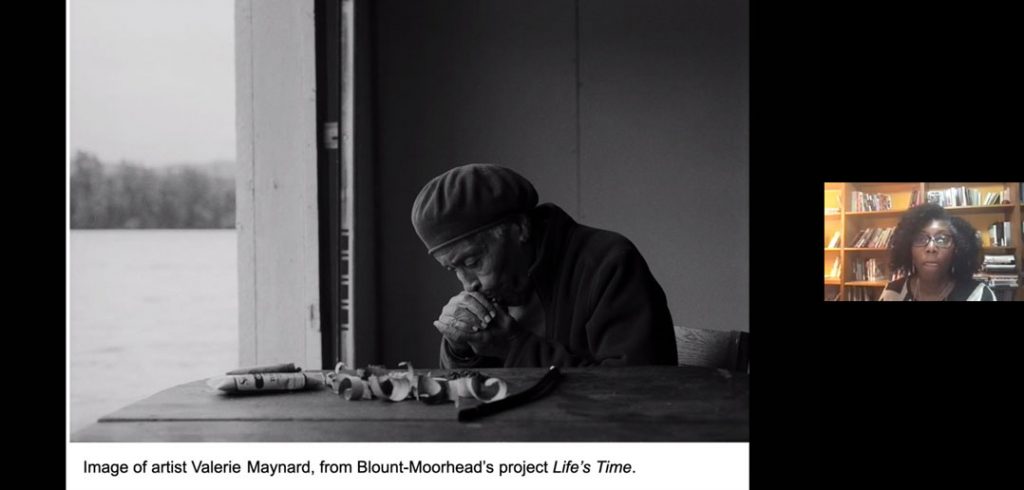The event featured presentations from Catherine Powell, J.D., professor of law, on the color and gender of COVID; Christina Greer, Ph.D., associate professor of political science on being Black in Biden’s America; and Michele Prettyman, Ph.D., assistant professor of communication and media studies on the politics of the Black image of rebirth. The webinar was hosted by Laurie Lambert, associate professor of African and African American Studies.
“Let me start with what I call the ‘color of COVID,’” Powell said. “I start with our current inflection point, our moment of interlocking pandemics of COVID-19, economic insecurity, and inequality.”
Powell said that we must examine the race and gender issues built into the COVID-19 pandemic to understand how this crisis relates to economic and social injustice. With Black and Latinx populations being overrepresented among essential workers, they’ve been exposed to COVID-19 more, she said. And they are more likely to have pre-existing conditions and live in congregate settings, which is part of why they’ve been disproportionately impacted by COVID-19, she said, both in terms of health and finances.
One way to think about addressing these pandemics is through a “viral convergence,” she said, a twist on civil rights scholar Derrick’s Bell’s theory of “interest convergence,” which argued that Black people have been able to achieve civil rights victories only when white and Black interests align.
“My idea of viral convergence is a recuperative project—one that seeks to span our shared and differential interests,” she said. “It calls for the adoption of transformative laws to reinforce our shared and unifying elements of our current crisis, while also addressing our differential vulnerabilities, whether in the context of the cross racial nature of the movement for Black Lives, or the rise of urban-suburban alliances that are paving the way for large scale inclusive politics.”
Greer said the alliances Powell discussed were instrumental in electing President Joe Biden. But she also noted that the current political landscape includes a “swinging pendulum” that moved dramatically from the first African American president to Donald Trump. That swing has brought large, overarching questions about how Black people are thinking about their roles in the country, she said.
“Can Black people ever be full citizens in this country? Can anyone who’s not white ever be a full citizen in this country, especially after what we just experienced for the past four years, and especially what we saw over January 6?” Greer said.
Biden, to start, has made efforts to swing the pendulum back, including putting together one of the most “inclusive cabinets,” Greer said. But he also has to deal with the historical context of these “multiple pandemics.” and “systemic inequalities.”
One way to continue to swing the pendulum, Greer said, is through the combination of “protest politics” and “electoral politics.”
“Black people in this country have never gotten anything without the duality of both,” Greer said. And I think a lot more Americans are understanding the power of protest politics, to change policy and to change electoral politics.”
Protests are some of the most common images depicted in the media of Black people and others fighting for justice, Prettyman said. She showed the image of TIME magazine’s cover from the Baltimore uprisings in 2015, featuring a photo of a Black man running from police. She asked everyone to consider what a “revolutionary image” might be in this time.
“As we consider this notion of a revolutionary image, I wonder, is it an image of protest, a visual articulation of defiance or resistance?” she said. Or, she said, “perhaps a revolutionary image is one that challenges that paradigm and offers us one of intimacy or care.”
Prettyman showed images from protests and from movies such as Judas and the Black Messiah, where Fred Hampton, a Black Panther leader from Illinois as played by Daniel Kaluuya, is depicted giving a rousing speech. She contrasted those to more everyday images of Black people working, living, experiencing joy.
“Is it possible that that is also a revolutionary image? Perhaps still, a revolutionary image is one that simply shows the everyday life of Black people doing nothing spectacular, nothing dramatic, titillating, or comedic?”
Lambert said these presentations worked together in a way “that’s blown my mind.”
“As we move through these dual pandemics, I thought that was great to ask us to reconsider images of joy and care and intimacy, and everyday life—seeking those out, finding those, but also thinking of them as the spaces of possibility where some of this work is going to be done,” she said.


